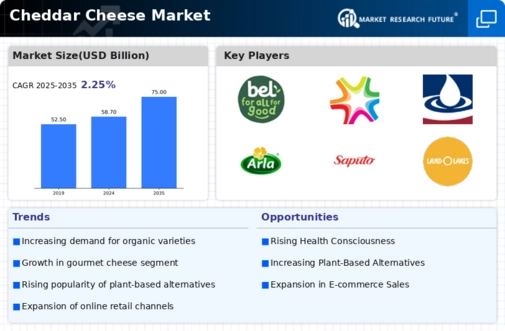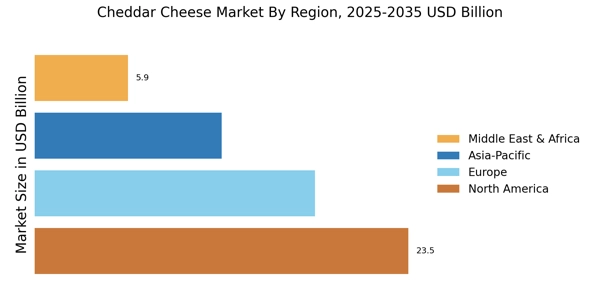Growth of the Snacking Culture
The rise of the snacking culture is reshaping consumer preferences and driving growth in the Cheddar Cheese Market. Cheddar cheese, often consumed in convenient formats such as cheese sticks and slices, aligns perfectly with the on-the-go lifestyle of modern consumers. Market Research Future indicates that the snack cheese segment has expanded by 15% in the last year, highlighting a shift towards cheese as a preferred snack option. This trend is particularly pronounced among younger demographics, who are increasingly seeking healthier snack alternatives. As the demand for convenient and nutritious snacks continues to rise, the Cheddar Cheese Market is poised to capitalize on this evolving consumer behavior.
Innovations in Cheese Production
Innovations in cheese production techniques are significantly impacting the Cheddar Cheese Market. Advances in technology, such as improved fermentation processes and enhanced aging methods, are leading to higher quality products. These innovations not only improve the flavor and texture of cheddar cheese but also increase production efficiency. Market data suggests that the introduction of new production methods has contributed to a 10% reduction in production costs for some manufacturers. As producers adopt these technologies, they are better positioned to meet the rising consumer demand for premium cheddar cheese, thereby driving growth within the Cheddar Cheese Market.
Expansion of E-commerce Platforms
The expansion of e-commerce platforms is transforming the way consumers purchase cheddar cheese, thereby influencing the Cheddar Cheese Market. Online grocery shopping has gained traction, with many consumers opting for the convenience of home delivery. Data shows that online sales of cheese products have increased by 20% in the past year, reflecting a shift in purchasing habits. This trend is particularly beneficial for specialty cheese producers, who can reach a broader audience without the constraints of traditional retail. As e-commerce continues to grow, the Cheddar Cheese Market is likely to see increased sales and a wider distribution of cheddar cheese products.
Rising Interest in Cheese Pairing
The rising interest in cheese pairing is enhancing the culinary appeal of cheddar cheese, thus benefiting the Cheddar Cheese Market. Consumers are increasingly exploring the art of pairing cheese with wines, fruits, and charcuterie, which elevates the dining experience. This trend is supported by market data indicating that cheese pairing events and workshops have seen a 30% increase in participation over the last year. As consumers become more knowledgeable about flavor profiles and pairings, the demand for high-quality cheddar cheese is expected to rise. This growing interest in gourmet experiences positions the Cheddar Cheese Market for continued expansion.
Increasing Popularity of Cheddar Cheese
The Cheddar Cheese Market is experiencing a notable surge in popularity, driven by its versatility and rich flavor profile. Cheddar cheese is increasingly being incorporated into various culinary applications, from gourmet burgers to artisanal pizzas. This trend is reflected in market data, which indicates that the demand for cheddar cheese has grown by approximately 5% annually over the past three years. Consumers are gravitating towards cheddar not only for its taste but also for its ability to enhance the overall dining experience. As restaurants and food service providers expand their menus to include more cheese-based dishes, the Cheddar Cheese Market is likely to benefit from this growing consumer interest.


















Leave a Comment